Photos & Story by Dave Weiman

Far be it from me to alarm my fellow aviators of the potential danger of “wildlife” on or near airports. But as a pilot who has encountered both deer on a runway, and a hawk while in the traffic pattern, I feel that “wildlife hazards ” at airports are worth considering.
I encountered the deer while on approach to St. Cloud Regional Airport (Minnesota) back in the 1970s. The airport did not have fencing around its perimeter at the time, and despite management’s efforts, deer were a problem. Now with deer-proof fencing around most public-use airports, they are less of a problem. Still, 782 deer were reported struck by aircraft in the FAA’s Wildlife Strike Database from 1990-2008. Fortunately, the pilot landing ahead of me saw the deer first, and they were gone by the time I touched down.
My encounter with a Red-tailed Hawk came in the 1980s while in the pattern at Middleton-Morey Airport in Middleton, Wisconsin. Ironically, I was flying a Cessna 172 “Skyhawk,” and never saw the bird until impact. The bird impacted the right corner of the windshield – probably the strongest part of the Plexiglas. I again landed without incident, and there was no damage to the aircraft.
Canada geese, too, are increasingly becoming a problem at airports. You do not have to be an Airbus A320 driver flying along the Hudson River to have a collision with Canada geese. Give a goose food, water, habitat and protection, and they will utilize your airport forever! Reduce these four elements and they will move to more hospitable environs. Eliminating geese on or near airports, however, can be challenging, politically.
Point in case: Dane County Regional Airport in Madison, Wisconsin, is currently trying to simply reduce the goose population at nearby Warner Park, and is finding it difficult with a segment of the local community. The airport enlisted the biologists at the Wildlife Services Division within the U.S. Department of Agriculture (USDA) to assist with a plan that included a reduction in the local, resident goose population. A “goose round-up” was proposed, which is a common method utilized nationally to reduce local population and minimize conflicts. The Madison Parks Commission put the action on hold after a public meeting drew many opponents of the plan.
The airport took the right action, they recognized a concern – geese are frequenting the airport environment, they validated their theory by following flocks back to the local park, consulted with qualified wildlife biologists and made a plan, and requested assistance from the park to help with their plan. The airport did everything it could do to realistically address the concern. If the unimaginable happens and a wildlife strike involving geese occurs, the resounding question will be “who was responsible?” In this case it is going to be hard to say that the airport was not responsive.
A look at incidents that occurred over a one-month period of time earlier this year demonstrates that airports are wise to proactively address wildlife issues.
On April 19, 2010, a Skywest Airlines Embraer EMB-120 Brasilia on a flight from Santa Barbara to Los Angeles, Calif., struck a bird while on short final to Los Angeles Runway 24R. The crew continued for a safe landing. The FAA reported that the bird struck the radome and windshield of the aircraft causing minor damage.
On April 23, 2010, a Chautauqua Airlines Embraer ERJ-145 on behalf of Delta Airlines from Raleigh/Durham, N.C. to Cincinnati, Ky., struck geese at the right side of the windshield on the climb-out. No injuries occurred, and the flight continued to Cincinnati, where the airplane landed safely about 65 minutes later with only minor damage.
On April 27, 2010, the crew of a Westjet Boeing 737-700 on a flight from Kahului, Hawaii to Vancouver, British Columbia, reported multiple bird strikes while landing on Vancouver’s Runway 08L. The airplane rolled out safely. A runway inspection revealed so many small bird carcasses (several hundred, in fact) that the sweepers were called out. The runway was closed for over 1 hour.
On May 23, 2010, a JetBlue Airbus A320-200 from Newburgh, N. Y. to Orlando, Fla., with 137 passengers onboard, ingested a bird into the left engine while climbing out of Newburgh’s Stewart Airport. The crew decided to return to Stewart for a safe landing 6 minutes later.
While these collisions did not result in any loss of human life, 219 people have been killed worldwide as a result of bird strikes alone since 1988, and those numbers are expected to increase as bird populations increase.
The North American non-migratory Canada goose population increased about four-fold from 1 million birds in 1990 to over 3.9 million in 2009. About 1500 Canada goose strikes with civil aircraft have been reported in the U.S. from 1990-2008, and there were about 5,000 bird strikes reported by the U.S. Air Force in 2008 alone.
From 1990-2004, U.S. airlines reported 31 incidents in which pilots had to dump fuel to lighten load during a precautionary or emergency landing after striking birds on takeoff or climb. An average of 11,600 gallons of jet fuel was released in each of these dumps.
From 1990-2009, over 400 different species of birds were involved in strikes with civil aircraft in the U.S. that were reported to the FAA.
Waterfowl (31%), gulls (25%), raptors (18%), and pigeons/doves (7%) represented 81% of the reported bird strikes causing damage to U.S. civil aircraft from 1990-2008.
As the bald eagle population has grown from 400 pairs in 1970 to over 11,000 pairs in 2008, so has the number of eagle strikes with civil aircraft has grown. Over 110 bald eagle strikes occurred between 1990-2008.
Bird and other wildlife strikes cost U.S. civil aviation over $600 million a year (1990-2008).
Over 780 civil aircraft collisions with deer and 280 collisions with coyotes were reported in the U.S. from 1990-2008.
Populations of many wildlife species are at the highest levels since records have been kept.
Even though a lot of data relating to wildlife strikes has been collected since 1990, it is estimated that only 39% of the strikes at Part 139 air carrier airports are reported.
There are many collisions that are not reported, or which receive less attention, so the problem is real. Aircraft collisions with wildlife can be costly to human life, insurance, and aircraft downtime.
Wildlife Hazard Assistance With Mead & Hunt, Inc.
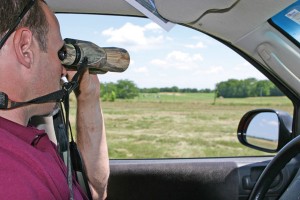
A Midwest firm leading the way in wildlife hazard assistance is Mead & Hunt, Inc., headquartered in Madison, Wisconsin, with offices nationwide. Heading up Mead & Hunt’s “Wildlife Hazard Assessment & Management Services” is Dan Hirchert, an FAA-qualified wildlife hazard biologist.
A veteran of the USDA Wildlife Services, Hirchert has 20 years of professional experience managing wildlife at airports and for municipalities. He has designed and conducted numerous wildlife hazard assessments; prepared management plans; and provided wildlife hazard identification and management training to operations staff at commercial service airports. He has also worked with project sponsors and design teams to review proposed projects for their potential to attract hazardous wildlife.
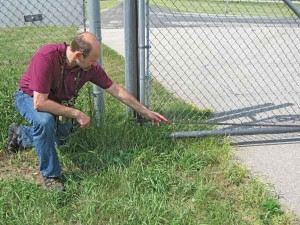
As part of the Mead & Hunt team, Hirchert works with planners, engineers, and other scientists to incorporate wildlife hazard management into compatible land-use planning efforts and aviation planning, design and construction management work.
I had the opportunity to tag along with Hirchert while he was conducting a survey for the ongoing wildlife hazard assessment at Southern Wisconsin Regional Airport in Janesville, Wis. Hirchert has projects underway in Wisconsin, Colorado, Oregon, Michigan and California.
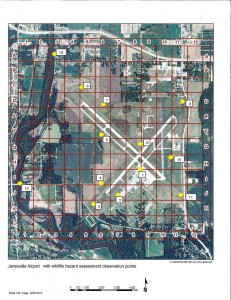
Every couple of weeks, Hirchert spends a day at Southern Wisconsin Regional Airport recording wildlife sightings at a number of checkpoints on and adjacent to the airport property. The airport is mapped using a grid overlay to record each location where animals are observed, and Hirchert has 13 checkpoints he stops at to record sightings.
The day we were out we saw a dozen or more Red-tailed Hawks, either flying around the airport, or perched on the fence surrounding the airport. While the fencing makes for a nice perch for the hawks, it has been extremely beneficial in keeping deer out of the airport property.
We did not observe any geese that day, but with the Rock River less than one-half mile from the airport and a healthy population inhabiting the parks in Janesville, the airport could become a popular location if not for the harassment efforts conducted by airport manager, Ron Burdick, and his operations staff. Hirchert says that if an airport can reduce the attractiveness of an animal’s habitat, the airport can generally change the animal’s behavior to select other locations to spend time.
A major conflict for airports exists between trying to generate revenue from open airport property and fields, and trying to manage landscapes to be unattractive to wildlife at the same time.
Corn, beans, wheat and hay are all potential habitat for wildlife. Expanses of grass maintained at a height of 8-14 inches is the grass height generally recommended by Hirchert to be unattractive to many small mammals and bird species. We saw a number of Coyote tracks and Woodchuck burrows on the airport property.
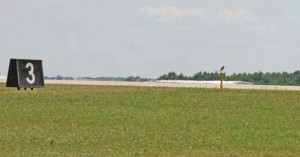
Some of the species of animals Hirchert has observed at or in the vicinity of Southern Wisconsin Regional Airport includes Red-winged Black Birds, Common Grackles, European Starlings, Brown-headed Cowbirds, House Finches, American Goldfinches, Grasshopper Sparrows, Savannah Sparrows, Song Sparrows, Field Sparrows, Eastern Meadow Larks, Horned Larks, Lapland Longspurs, American Crows, Red-tailed Hawks, American Kestrels, Barn Swallows, Canada Geese, Mallards, Great Blue Herons, Sandhill Cranes, Wild Turkeys, Ring-necked Pheasants, Cedar Waxwings, American Robins, Bobolinks, Upland Sandpipers, Downey Woodpeckers, American White Pelicans, Killdeers, Ring-billed Gulls, Mourning Doves, and Rock Doves.
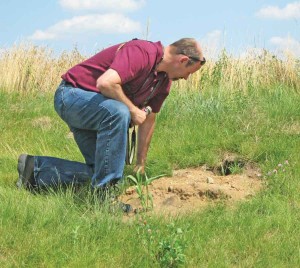
Mammals observed in the vicinity of Southern Wisconsin Regional Airport include White-tailed Deer, Woodchucks, Coyotes, Thirteen-lined Ground Squirrels, and Gray and Fox Squirrels. The wildlife hazard assessment takes in adjacent properties and is greater than the airport operations area. This list of wildlife gives us an idea of the wildlife that exists on or near an airport that most of us pilots will never see until it is too late.
Hirchert encourages pilots to report any and all wildlife strikes online at: http://wildlife-mitigation.tc.faa.gov/wildlife/default.aspx. This data is reviewed annually and helps biologists make recommendations to improve conditions and for future research.
Lastly, if you observe wildlife that could pose a safety concern for other pilots, report it over Unicom to other aircraft, and to airport management after you land.
Wildlife assessments and management plans are eligible for state and federal funding. Dan Hirchert can assist airport managers with this information by calling
608-443-0622, or by emailing: Dan.Hirchert@meadhunt.com.
Attentive Flying Habits Are Needed
While wildlife pose an ever-increasing threat to flying, pilots need to maintain awareness of other potential hazards on or near airports as well, including other aircraft, towers, obstructions on runways, and construction projects.
For instance, while on final to land at an airport earlier this summer, I noticed an airport vehicle parked on the end of the runway, and then without making any announcement over the radio, the worker drove down the center line looking for debris. It was an uncontrolled, rural airport, and I was on a one-mile final approach when I first spotted him. The worker failed to respond to my position announcements, and when I proceeded to go around, he picked up the microphone and explained that it had fallen onto the floor of the truck, but that he heard my announcements. Why he did not pull off the runway before he picked up the microphone from the floor, I don’t know. But I do know I could have easily become the first of five acts in the air show that day, performing a truck-top landing.
In another incident, a friend of mine was unable to obtain NOTAMS for the airport he was flying to using one of the online flight planning programs, so opted to call unicom for this information upon his arrival. Arriving after hours, no one was at the airport to give him NOTAMS, and unbeknown to him, the runway he was lined up to land on had been closed, but was properly marked with an X. Busy with preparing to land, the pilot did not see the X, but his passenger did and they averted a potential accident and landed safely on the crosswind runway.
Maintaining vigilance, especially while in the pattern and landing mode of the flight, is important, whether the potential hazard is wildlife or manmade.